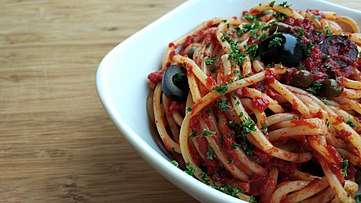Spaghetti alla puttanesca
Spaghetti alla puttanesca (pronounced [spaˈɡetti alla puttaˈneska]; in Italian) is an Italian pasta dish invented in Naples in the mid-20th century. Its ingredients typically include tomatoes, olive oil, olives, capers and garlic, in addition to pasta.[1]
 spaghetti alla puttanesca | |
| Alternative names | pasta alla puttanesca, pasta puttanesca |
|---|---|
| Course | Main |
| Place of origin | Italy |
| Region or state | Campania |
| Serving temperature | Hot |
| Main ingredients | Spaghetti, tomatoes, olives, capers, garlic |
| Variations | spaghetti alla puttanesca with anchovies or tuna |
Origin
Various recipes in Italian cookbooks dating back to the 19th century describe pasta sauces very similar to a modern puttanesca sauce under different names. Among the earliest dates from 1844, when Ippolito Cavalcanti, in his Cucina teorico-pratica, included a recipe from popular Neapolitan cuisine, calling it Vermicelli all'oglio con olive capperi ed alici salse.[2] After some sporadic appearances in other Neapolitan cookbooks, in 1931 the Touring Club Italiano's Guida gastronomica d'Italia lists it among the gastronomic specialties of Campania, calling it "Maccheroni alla marinara",[3] although the proposed recipe is close to that of a modern puttanesca sauce. In Naples, this type of pasta sauce commonly goes under the name aulive e chiapparielle (olives and capers).
The dish under its current name first appears in gastronomic literature in the 1960s. The earliest known mention of pasta alla puttanesca is in Raffaele La Capria’s Ferito a Morte (Mortal Wound), a 1961 Italian novel which mentions "spaghetti alla puttanesca come li fanno a Siracusa (spaghetti alla puttanesca as they make it in Syracuse)".[4] The sauce became popular in the 1960s, according to the Professional Union of Italian Pasta Makers.[5]
Nonetheless, the 1971 edition of the Cucchiaio d’argento (The Silver Spoon), one of Italy's most prominent cookbooks, has no recipe with the name puttanesca, but two recipes that are similar: The Neapolitan spaghetti alla partenopea, is made with anchovies and generous quantities of oregano; while spaghetti alla siciliana is distinguished by the addition of green peppers. Still again there is a Sicilian style popular around Palermo that includes olives, anchovies and raisins.[6]
In a 2005 article from Il Golfo—a daily newspaper serving the Italian islands of Ischia and Procida—Annarita Cuomo asserted that sugo alla puttanesca was invented in the 1950s by Sandro Petti, co-owner of Rancio Fellone, a famous Ischian restaurant and nightspot.[7] According to Cuomo, Petti's moment of inspiration came when—near closing one evening—Petti found a group of customers sitting at one of his tables. He was low on ingredients and told them he did not have enough to make them a meal. They complained that it was late and they were hungry, saying "Facci una puttanata qualsiasi," meaning "throw together whatever."[a] Petti had nothing more than four tomatoes, two olives and some capers—the basic ingredients for the sugo, "So I used them to make the sauce for the spaghetti," Petti told Cuomo. Later, Petti included this dish on his menu as spaghetti alla puttanesca. However, due to "puttana" meaning "whore" or "prostitute," it has generated the theory that the dish was invented in one of many bordellos in Quartieri Spagnoli.[8][9]
Basic recipe
The sauce alone is called sugo alla puttanesca in Italian. Recipes may differ according to preferences; for instance, the Neapolitan version is prepared without anchovies, unlike the version popular in Lazio. Spices are sometimes added. In most cases, however, the sugo is a little salty (from the capers, olives, and anchovies) and quite fragrant (from the garlic). Traditionally, the sauce is served with spaghetti, although it is also paired with penne, bucatini, linguine, and vermicelli.
Garlic and anchovies (omitted in the Neapolitan version) are sautéed in olive oil. Chopped chili peppers, olives, capers, diced tomatoes, and oregano are added along with salt and black pepper to taste. The cook then reduces this mixture by simmering and pours it over spaghetti cooked al dente. The final touch is a topping of parsley.[10]
In popular culture
The dish is featured in The Bad Beginning from the novel series Lemony Snicket's A Series of Unfortunate Events as the dish the Baudelaire children prepare at Count Olaf's house. The dish also features prominently in the movie based on the novels, as well as the Netflix original series. Count Olaf is very upset that they had not prepared roast beef for him instead.[11]
See also
Notes
^ a: In this usage, puttanata is an Italian noun meaning something worthless. It derives from the Italian word for whore, puttana.
References
- Zanini De Vita & Fant 2013, p. 68.
- Cavalcanti, Ippolito (1844). La cucina teorico-pratica, ovvero Il pranzo periodico di otto piatti al giorno. Naples: Stamperia e cartiere del Fibreno. p. 179.
- Guida gastronomica d'Italia. Milan: Touring Club Italiano. 1931. p. 362. ISBN 9788836529407.
- The dictionary entry is cited in Jeremy Parzen, ‘The origins of Sugo alla puttanesca?’, Do Bianchi, 13 January 2008, an article which supplied a number of the sources used here.
- ‘Sughi d’Italia: 1000 anni di pasta, 1000 anni di condimenti’ Archived 23 October 2007 at the Wayback Machine, Unione Industriali Pastai Italiani
- Il nuovissimo cucchiaio d'argento, ed. by Antonia Monti Tedeschi, 6th edn (Editoriale Domus, 1971), pp. 220–221
- Annarita Cuomo (17 February 2005). ‘Il sugo “alla puttanesca” nacque per caso ad Ischia, dall'estro culinario di Sandro Petti’. Il Golfo. Archived from the original on 13 August 2014
- "How to make the classic pasta alla puttanesca". thelocal.it. 17 May 2019.
- "Pasta Puttanesca: What's With the Name?". italymagazine.com.
- Recipe on the site for the Accademia Italiana della Cucina Archived 7 October 2014 at the Wayback Machine
- Lemony, Snicket. The Bad Beginning. Helquist, Brett (1st ed.). New York. pp. 41–46. ISBN 0060283122. OCLC 41070636.
- Zanini De Vita, Oretta; Fant, Maureen B. (2013). Sauces & Shapes: Pasta the Italian Way. New York: W. W. Norton & Company. ISBN 978-0-393-08243-2.CS1 maint: ref=harv (link)
